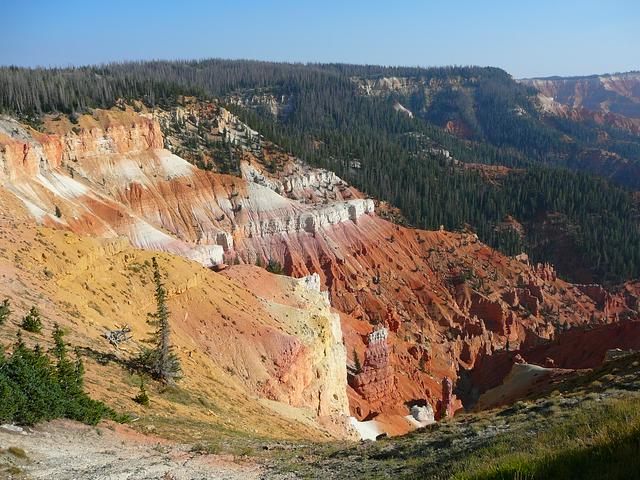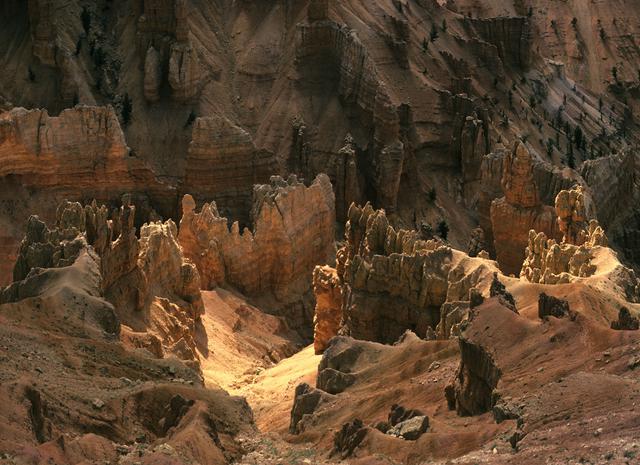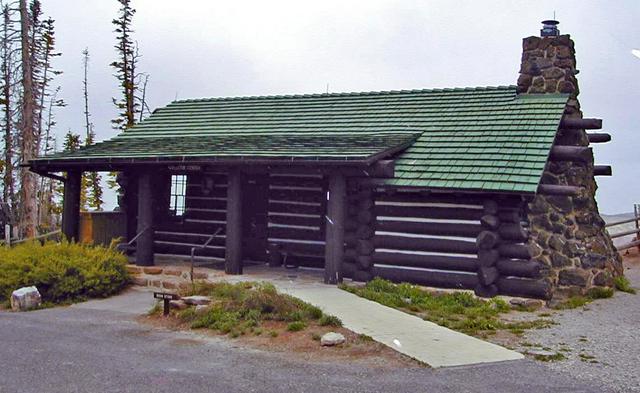
Cedar Breaks National Monument is a United States National Monument that is located in the Dixie region of Utah.
The wild and rugged land compromising the area where Cedar Breaks lies today was known to 1800 Mormon settlers as "Breaks," due to how difficult it was to travel in the area. In the 1920s Iron and Kane Counties worked together to have a road constructed from Cedar City to Highway 89. A paved road up to Cedar Breaks was also built. President Franklin D. Roosevelt named Cedar Breaks a National Monument on August 22, 1933. The monument is managed today by the National Park Service. In the summer of 2006 parties have worked to have this outstanding monument become a National Park.
Impressive! Cedar Breaks is one of those places that is breath taking. The single amphitheater is filled with shapes and the subtle colors of limestone formations that are incredible. Surrounding the amphitheater are high alpine meadows covered in an array of wildflowers.
You would think the place would be filled with Cedar trees, but there is not a one in sight. Instead there are juniper trees that the early settlers mistook for Cedar trees. This is a high elevation monument however and although there are junipers, there are many more aspen and spruce. Due to the spruce beetle however, a live and thriving spruce tree is becoming a rare sight. The fir beetle has been doing some damage on the mountain lately as well. The bristlecone pine and fir trees dots the landscape in many places in the monument. The bristlecone is thought to be the oldest living thing in the world even though the Aspen, according to some scientists, might just be older.
At 10,000 feet the fauna living on the mountain must be hardy. Seen around the monument are deer, squirrels, chipmunks, pika and gophers.
The monument has a cool, alpine climate.

The entrance fee for the monument is $4 per person, good for 7 days.

- Cedar Breaks Amphitheater. From all 5 pull-outs.
- Cedar Breaks Visitor Center. This rustic old building is wonderful!
Cedar Breaks Amphitheater. From all 5 pull-outs.
Cedar Breaks Visitor Center. This rustic old building is wonderful!
- Alpine Pond Trail. A great family hike through the forest to a nice pond.
- Spectra Point & Wasatch Ramparts Trail. A moderate trail to a nice view of the amphitheater.
- Cedar Breaks Bottoms. A seldom done trail that begins in Dixie National Forest and ends down at the hoodoos seen from the rim of Cedar Breaks National Monument.
- Twisted Forest Trail. A nice meander through the bristlecones.
- Ashdown Gorge - Rattlesnake Creek. An impressive hike. It starts as a meander down hill through the bristlecone with views of the Cedar Breaks Amphitheater and ends in the gorge near Cedar City.
Alpine Pond Trail. A great family hike through the forest to a nice pond.
Spectra Point & Wasatch Ramparts Trail. A moderate trail to a nice view of the amphitheater.
Cedar Breaks Bottoms. A seldom done trail that begins in Dixie National Forest and ends down at the hoodoos seen from the rim of Cedar Breaks National Monument.
Twisted Forest Trail. A nice meander through the bristlecones.
Ashdown Gorge - Rattlesnake Creek. An impressive hike. It starts as a meander down hill through the bristlecone with views of the Cedar Breaks Amphitheater and ends in the gorge near Cedar City.
There is a nice book store in the rustic visitor center.
There is no food sold inside the monument. Nearby towns with restaurants include Duck Creek, Mount Carmel Junction and Cedar City.
Drinks are not sold inside the monument. Nearby Communities where drinks are sold include Duck Creek, Mount Carmel Junction and Cedar City.
When hiking in the backcountry always let someone know where you are going and when you expect to be back. Avoid hiking rainy days if hiking Ashdown Gorge or any other slot canyon.
- Zion National Park is a popular Utah National Park. Many that come to visit Zion take the quick jaunt over to visit Cedar Breaks.
Nearby towns and communities:
- Duck Creek Village
- Mount Carmel Junction, Glendale, Orderville.
- Cedar City
- Brianhead Ski Resort
